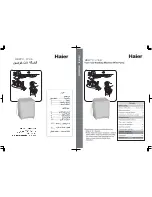
DiBO n.v. 57
2. Before bring in use
For each start up all substantial parts of the high pressure cleaner must be checked by taking them in consideration
like for example: is the lance joint still stuck firmly, check high pressure hoses and electric wiring on damages. Check,
before plugging the plug in the socket, if the electric indications on the name blade are suitable with the values of the
main supply (for example: electric tension,...).
Operating the machine. Rinse the hoses, gun and lance minimum 1 minute with clean water.
(Aim the gun in the free space). Check if of the object to clean can come dangerous goods like e.g. asbestos and oil
loose and can pollute the environment. Persuade yourself of the safety regulations from previous chapter.
Leave the main switch on stand 0: OFF.
2.1. Accomplish water supply and water outlet
2.1.1. Accomplish water supply
The water supply pipe can be connected (towards circumstances) on their own water supplies (under pres-
sure) or on a drinking water supply with a water barge. When the machine is connected to the drinking water
supply, the existing regulations about that must be observed ( EN 1717 ).
Water supply under pressure:
Maximum hose length 50 m ( 160 ft ), minimum hose diameter ( inside ) 12.7 mm (1/2”).
Check the water pressure using a water meter.
2.1.2. Carry away water
Check that all water outlets have been correctly connected on the sewerage.
Take the necessary measures so that the effluent is pure enough to drain.
2.1.3. Anti- legionella bacterium measure
If the machine has stood still some time, the water in the machine must be drained above an evacuation.
Stationary water that between 20 - 55°C warm is can cause the legionella bacterium.
- Clean therefore yearly piping and tanks.
- Remove possible sediment.
- Rinse periodically.
2.2. Filling the fuel tank
The cleaner will be delivered with empty fuel tank, fill the tank with the right fuel
before
the first use.
When the fuel tank is empty, the fuel pump runs dry and these become defective!
Avoid mess of fuel, certainly on warm machine parts.
The tank of the burner fill with light fuel oil or diesel oil ( DIN 51 603 ).
Respect the fill capacity of the fuel tank. See technical data for tank reserve and fuel type.
At temperatures under 8°C the fuel starts coagulate (paraffin dissidence). As a result, difficulties can arise
at starting the diesel engine and/or burner. DiBO advise to add an coagulation point - or flow improvement
during the cold period (winter months) to the fuel. As an alternative “winter diesel” can be refuelled in a filling
station.
Содержание IBH-L Series
Страница 2: ...DiBO n v 2 ...
Страница 28: ...DiBO n v 28 ...
Страница 52: ...DiBO n v 52 ...
Страница 75: ...DiBO n v 75 ...
Страница 99: ...DiBO n v 99 11 Technical data ...
Страница 109: ...DiBO n v 109 12 Nozzles ...
Страница 111: ...DiBO n v 111 ...
















































